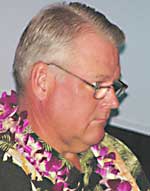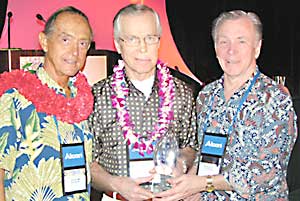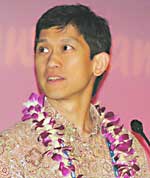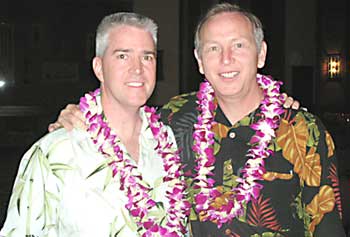Range of severity of IFIS requires varied management strategies, surgeon says

KOLOA, Hawaii – Because the severity of intraoperative floppy iris syndrome can vary significantly between patients and even between two eyes of the same patient, cataract surgeons need a variety of tools to handle any scenario, according to David F. Chang, MD.
 David F. Chang |
Speaking here at Hawaiian Eye 2007, Dr. Chang said symptoms of intraoperative floppy iris syndrome (IFIS) can range from mild, marked by good dilation but a slight billowing, to moderate, marked by some tendency for iris prolapse and some pupillary constriction, to severe, categorized by classic triad and poor preoperative dilation.
Surgeons should determine a patient’s history of alpha-blockers in order to know which strategy should be employed, either alone or in combination, said Dr. Chang, an OSN Cataract Surgery Section Member.
In mild to moderate cases, Dr. Chang said he takes an adjunctive pharmacologic approach. Intracameral alpha-agonists, such as phenylephrine and epinephrine can be effective in adding “greater tone to the iris dilator smooth muscle, resulting in a more rigid iris,” Dr. Chang said.
“It makes the iris very rigid and prevents the billowing you would normally see when the [viscoelastic] is removed,” he said. “It’s a wonderful adjunct for any small pupil case.”
He cautioned that only unpreserved solutions should be used, and that mixtures should be diluted to buffer the pH level.
Dr. Chang also discussed iris retractors as a “100% reliable” strategy for pupil expansion in IFIS patients.
“For very severe cases there is nothing like iris retractors,” he said.
The hook is placed subincisionally to retract the iris downward and away from the phaco tip, “giving great chopping exposure.” He added that he uses 4-0 polypropylene retractors from Katena, which he said are easy to manipulate. They are also cost-effective because they can be repeatedly autoclaved.
The following are other highlights from the Hawaiian Eye 2007 meeting including Subspecialty Saturday. Most of these items appeared first as daily coverage on OSNSuperSite.com and in the onsite daily publication, Hawaiian Eye Daily News.
Zigzag-pattern PK
Early results of zigzag-pattern penetrating keratoplasty performed with a femtosecond laser show the procedure to improve postoperative outcomes, according to a presenter here.
|
Image: Mullin D, OSN |
The zigzag configuration, which can only be made with a femtosecond laser, “is biomechanically stable and secure and surgically straightforward,” said Roger F. Steinert, MD, at the Subspecialty Saturday meeting. “The advantage of the zigzag PK is that the watertight seal gives a smooth transition,” he said.
Dr. Steinert performed the zigzag PK procedure on 16 eyes with up to 9 months’ follow-up with the IntraLase femtosecond laser (Intralase Corp.). He performed a 0.5-mm lamellar ring cut at a depth of 320 µm, with 45° angles and 24-bite 10-0 nylon running suture closure.
Topography showed that at 3 months, six out of eight eyes were at or less than the 3.5 D SimK mean. Four out of five eyes showed a best corrected visual acuity of 20/40 to 20/80. Dr. Steinert noted that typically with conventional PK it takes 6 months to regain functional vision and with Descemet-stripping lamellar endokeratoplasty it normally takes 3 months.
Postoperative evaluation with the Visante OCT (Carl Zeiss Meditec) “shows strong healing, and it shows that at 3 months there is a greater signal at the wound, which may correlate with wound healing,” Dr. Steinert said.
He said he is working with Carl Zeiss Meditec, maker of the Visante OCT, to digitize the image to verify if this is quantifiably indicative of wound healing.
He also noted that the OCT image indicated that the procedure is an improvement over conventional methods.
“You can see in the image the suture is absolutely perfectly aligned, telling us biomechanically we’re doing something right here,” he said.
Dr. Steinert said the next step is a randomized prospective comparison of femtosecond PK with conventional PK.
NSAIDs should be routine in cataract surgery
Now that four safe and effective nonsteroidal anti-inflammatory drugs are available to enhance surgical outcomes, their use should be standard of care among cataract surgeons, said Michael B. Raizman, MD.
He noted that NSAIDs should be used for four main indications: reduction of postoperative cell and flare, prevention and treatment of cystoid macular edema (CME), maintenance of pupil dilation during surgery, and the control of pain during and after surgery.
The four NSAIDs that Dr. Raizman referred to are Voltaren (diclofenac, Novartis), Acular LS (ketorolac tromethamine 0.4%, Allergan), Nevanac (nepafenac sodium, Alcon) and Xibrom (bromfenac, Ista Pharmaceuticals).
In the absence of strong head-to-head data comparing the available NSAIDs for all four of these indications, surgeons will have to rely largely on their own clinical experience to determine which to use.
“For now we can feel comfortable using any of these agents,” Dr. Raizman said. “I would stress that the important thing is to use them. It’s not so much about which you should use, but that they should be used.”
He added that the duration of use should be extended in patients with a higher risk of developing CME, including those with diabetes, uveitis, pupil manipulation during surgery, vitreous loss, CME in the other eye, retinal vascular disease or epiretinal membrane.
In these patients, he starts NSAID use up to 1 week before surgery, rather than the typical 2 to 3 days, and continues them for 6 weeks or longer postoperatively.
|
Image: Wolkoff L, OSN |
Be alert to avoid TASS
The incidence of toxic anterior segment syndrome is low – estimated at around 0.1% to 2% – but “it appears to be growing,” according to surgeon speaking here.
In light of this, Terry Kim, MD, said the surgeon is the key to recognizing the problem immediately and alerting the appropriate staff or other centers to take swift action.
Toxic anterior segment syndrome (TASS) occurs in clusters or outbreaks, so it could indicate that something has changed in the office setting that might be provoking it.
“You may have some change in your sterilization protocol that you might not even be aware of,” Dr. Kim said. “It is certainly an environmental and toxic control issue, and it does require an investigation and a complete analysis.”
He urged surgeons to pay close attention to any medication they inject into the anterior chamber and to be attuned to any changes in operating and sterilization protocol.
“But you are the key in identifying any epidemic of TASS, because you’ll be seeing these patients postoperatively,” Dr. Kim said.
Surgeons should take prophylactic measures to ensure that TASS and other infections do not enter the eye peri- or postoperatively.
Alternative ways to seal wounds to help bacteria and organisms from entering the eye are also becoming available, Dr. Kim said. A new liquid sealant called OcuSeal, a synthetic hydrogel bandage developed by Hyperbranch, is designed for direct application on the ocular surface to protect the wound.
“This might indicate a paradigm shift, moving away from sutures to alternative modes for sealing wounds,” he said.
Supracapsular phaco an option for refractive lens surgery
Supracapsular phacoemulsification is particularly suited to refractive cataract surgery, which is often done in softer nuclei, said Richard L. Lindstrom, MD, Hawaiian Eye 2007 meeting co-program chair and OSN Chief Medical Editor.
|
Image: Wolkoff L, OSN |
Dr. Lindstrom said the supracapsular phacoemulsification technique is safe and fast, particularly for softer lenses. In addition, because the nucleus is brought anteriorly, above the iris plane, this technique is well- suited for floppy iris syndrome, as the nucleus will hold the iris down during phacoemulsification. And because the phacoemulsification is performed more anterior, there is greater distance from the posterior capsule, which may translate to an increased safety margin for the prevention of capsular breaks and vitreous prolapse, he said.
The technique involves performing a sufficiently large capsulorrhexis, at least 5 mm in diameter, followed by significant hydrodissection. Dr. Lindstrom performs the hydrodissection in a controlled, pulsatile manner in order to prolapse the nucleus out of the capsular bag. Once the nucleus is partially tilted out of the capsular bag, the nucleus can be further prolapsed by injecting viscoelastic behind it.
The 30° phaco tip is placed bevel down to direct the ultrasound energy into the cataract and away from the corneal endothelium. Dr. Lindstrom employs higher vacuum for this technique, using 300 mm Hg to 400 mm Hg for a venturi pump and 400 mm Hg to 600 mm Hg for a peristaltic pump. Although a moderate to high flow rate is used for the infusion, a flow restrictor is used on the outflow tubing to maintain a stable anterior chamber.
At the end of the case, hydration of both the primary clear corneal incision as well as the paracentesis is performed in order to ensure a watertight eye. Standard postoperative topical mediations include a fluoroquinolone, a corticosteroid, and a nonsteroidal anti-inflammatory drug, he said.
In a study performed by Dr. Lindstrom and colleagues, he noted a 4% endothelial cell loss rate for routine cataracts, which have preoperative visual acuities of 20/30 to 20/70. This technique is not recommended for dense brunescent cataracts, where an endocapsular approach would likely enable greater corneal endothelial cell protection. For the majority of refractive cataract patients, the ease of the supracapsular technique and the increased safety margin from being away from the posterior capsule makes this an excellent technique that most surgeons can learn and implement.
Cavitation research tops list of cataract innovations in 2006
| Gimbel receives Foundation award
|
A video on the role of cavitation in phacoemulsification, which “should be required viewing” for all cataract surgeons, topped the list of ophthalmic innovations in 2006, according to Robert H. Osher, MD.
Dr. Osher presented his list of the top 10 innovations in cataract surgery here at the meeting.
The video by Jaime Zacharias, MD, titled “Jackhammer or Cavitation: The Final Answer,” was originally presented at the American Society of Cataract and Refractive Surgery in San Francisco and was awarded the 2006 ASCRS Film Festival Grand Prize.
It was also described by Dr. Zacharias in Ocular Surgery News in the article “Study finds that cavitation plays no role in cutting cataract tissue,” in the June 1, 2006 issue.
“This is a magnificent film that should be required viewing, challenging the long-standing accepted view of cavitation being beneficial in phacoemulsification,” Dr. Osher said.
The second most important innovation of 2006, according to Dr. Osher, was an IOL developed by Bausch & Lomb for megophthalmos, called the Ashhab custom lens. The lens features an overall diameter of 16 mm.
Tying for second place was the new Maxfield 78 D Osher surgical lens.
“It’s been a great secret in ophthalmology,” Dr. Osher said. “I take no royalties for it at all, but they’ve now coated it with a high-definition coating, which gives wonderful brightness. If I want to see a posterior pole, if I want to look around the periphery with positive pressure, or if I want to make sure the optic nerve is perfusing, I slip it right under the operating room microscope and see a beautiful fundus view.”
Third on the list was a small-incision artificial iris produced in Russia. Dr. Osher noted that the lens will be highlighted in the next issue of his Video Journal of Cataract and Refractive Surgery.
The fourth innovation was the radius tip design on a phaco tip produced by MicroSurgical Technologies.
“The rounded phaco needle is an exciting idea from Steven H. Dewey. If you just think back a few short years, we were popping capsules at an alarming frequency with sharp metal burrs inside the irrigation-aspiration tip,” Dr. Osher said. “Alcon came out with this brilliant innovation of a silicone tip, which I’m still amazed is not used by everybody. The rates of posterior capsular tear have plummeted. You can capture the capsule at 500 mm Hg and not break the capsule. What’s wrong with looking at a very rounded, blunt phaco tip as well? I think it’s a very innovative idea.”
At No. 5 on Dr. Osher’s list was the eyejet, a pre-loaded capsular tension ring injector, from Morcher in Germany.
“It makes injecting a capsular tension ring an absolute piece of cake. There’s no manipulation; there’s no loading; there’s no ‘oops,’” Dr. Osher said.
No. 6 was a photochromatic IOL developed by Medennium to block ultraviolet and blue light. It is clear in normal indoor light and changes to yellow when exposed to UV light, Dr. Osher said.
No. 7 on the list was a tie between the high-definition Sony 1950 D monitor and the NEIOM surgery system.
According to Dr. Osher, the Sony monitor gives 750 to 800 lines of resolution.
“It is spectacular. I have never seen such clarity with a monitor,” he said.
According to a video played by Dr. Osher, the NEIOM surgery system allows surgery to be performed in ambient room light alone, thereby reducing the risk of phototoxic retinopathy and possibly reducing the amount of mydriatic agent needed for pupil dilation. The system also allows four additional people to view the operation from the surgeon’s viewpoint with head-mounted displays, making it an educational tool as well, he said.
“Just like we’ve used phaco for 35 years, we have used standard surgical microscopes forever, and some of these exciting new techniques, such as a virtual reality headset that reduces light toxicity and improves education, make a lot of sense,” Dr. Osher said.
No. 8 was the practice of hydrating the cataract incision using vancomycin.
“Hydrating the cataract incision with vancomycin is a really interesting concept because the natural transition is how to get antibiotic inside the eye,” Dr. Osher said. “There’s no question there’s now a lot of interest in intracameral antibiotics.”
No. 9 was the introduction of the Akreos IOL from Bausch & Lomb.
“I predict this will be the first sub-2-mm IOL available in the U.S. There have been 1.5 million implanted around the world,” Dr. Osher said. “It is a single-piece lens with a 6-mm optic, with a double-square-edged biconvex shape and a refractive index of 1.46.”
Rounding out the list at No. 10 was the BD Medical Ophthalmics 2.2-mm guarded blade.
“The blade is extremely sharp and gives a beautiful square incision. Shielding the blade gives unparalleled safety,” Dr. Osher said.
Trabeculectomy offers advantages as first-line glaucoma treatment
|
Image: Wolkoff L, OSN |
Although most specialists will reach for one of the new generation of glaucoma medications as the first treatment option for glaucoma, there is a role for trabeculectomy as a first-line treatment in cases of advanced glaucoma, according to Philip P. Chen, MD.
Dr. Chen said trabeculectomy offers a rapid IOP-lowering effect, and its use as first-line treatment is supported by several prominent clinical trials. The surgery-first approach presents a “finite but small” risk, which can be minimized by certain surgical techniques, he said.
“Trabeculectomy reduces IOP faster and for the long term. It reduces IOP variability and reduces the need for treatment compliance,” Dr. Chen said. “The risks are acceptable and can be minimized.”
However, Dr. Chen cautioned that “experience matters.”
“If you don’t perform many surgeries, this might not be the way for you,” he said.
Dr. Chen noted that a 1994 trial at Moorfields Eye Hospital in London, which compared primary surgery and medication, found that after 6 to 8 years, surgery provided lower IOP and less visual field loss than medication. He also cited similar findings in the 1989 Glasgow Trial, the Collaborative Initial Glaucoma Treatment Study, the Advanced Glaucoma Intervention Study and others.
According to Dr. Chen, trabeculectomy decreases fluctuation in IOP, which has been linked in studies to glaucoma progression. He said surgeons can avoid bleb-related problems, such as pain, bleb leak, endophthalmitis and bleb failure, through careful surgical technique.
Detecting optic nerve variation essential in glaucoma
A careful evaluation of the optic nerve is “indispensable” to early detection of glaucoma, according to Jody R. Piltz-Seymour, MD, who described various factors glaucoma specialists should consider in their evaluation of the optic nerve and explained why she feels this is critical.
|
Image: Wolkoff L, OSN |
“You can have glaucoma diagnosed and followed well before visual field loss is detected, so a careful evaluation of the optic nerve is indispensable,” said Dr. Piltz-Seymour. “Imaging has revolutionized following the progression of glaucoma and helping in its diagnosis, but nothing replaces looking carefully at the optic nerve,” she said.
When it comes to looking for optic nerve irregularities, Dr. Piltz-Seymour said “the more you look, the more you’ll see.”
She advised attendees to use stereopsis and magnification when possible; to look for contour changes in both color and shape; and compare the eye to a normal optic nerve as well as to the contralateral eye.
Use the acronym SHIP to remember the four elements to evaluate, she said. These include size, hemorrhage, the “ISN’T” rule and peripapillary atrophy.
The ISN’T rule refers to the inferior, superior, nasal and temporal thickness of the neural retinal rim, Dr. Piltz-Seymour said. She also stressed that size is important when it comes to optic nerve evaluation.
“You need to have an appreciation of the size of the optic nerve to appreciate whether the cup/disc ratio you are looking at is significant,” she said.
Dr. Piltz-Seymour said she advocates the inclusion of a baseline photo of the optic nerve in the patient’s chart so she can easily see what changes have occurred.
Laser eye surgery evolves in military
After promising results in a series of studies, Navy officials have chosen to proceed cautiously with a program allowing LASIK with IntraLase flap creation in naval aviators. To date, PRK has been the preferred method of refractive surgical correction for Navy pilots.
“We treated the first aviator about 2 months ago using the best of this technology ... in a very slow, progressive fashion,” said Steven C. Schallhorn, MD, of the Naval Medical Center in San Diego.
Dr. Schallhorn, who has helmed several studies of refractive surgery in military personnel, reviewed their results in a presentation. He also announced his intention to retire from the Navy at the end of January. (See related item below.)
The military was initially reluctant to allow LASIK, based on a study in which Dr. Schallhorn and colleagues compared conventional PRK with conventional LASIK. Although both procedures resulted in a slight loss in contrast sensitivity, the contrast sensitivity in the PRK group recovered within 6 months postop, while in the LASIK group it did not, he said.
“This is the reason we haven’t done LASIK in aviators,” Dr. Schallhorn said. “Everyone asks me, ‘Why don’t you do LASIK in aviators? Is it because of flap stability?’ No, we published studies on flap stability years ago. … It was really the quality of vision with conventional LASIK.”
A study in the early 1990s examined the in-flight effects of PRK on the vision of 785 active aviators, he said.
“The results were quite excellent in them. Not without complications, but we had an overall excellent clinical result,” he said. “This study changed our Department of Defense vision standards. It has changed the standards of most countries’ departments of defense.”
Dr. Schallhorn noted that the “Achilles’ heel” of PRK is the slow visual recovery period.
“The minimum down time for an aviator after PRK is 3 months. There’s no question that LASIK offers faster visual recovery,” he said.
The unsatisfactory visual results led Dr. Schallhorn on a quest for better technology. A large series comparing conventional LASIK with wavefront-guided LASIK found that the newer technology caused fewer higher-order corneal aberrations and thus yielded better visual results, he said.
Another study aimed to compare the IntraLase FS laser with a variety of microkeratomes for flap creation.
“We found that the quality of vision and the visual recovery favored the femtosecond laser,” he said.
In December, IntraLase announced that the Department of Defense had awarded the company a $45 million, 5-year contract to supply its FS femtosecond lasers, maintenance and support to the U.S. Army, Navy, Air Force, Marine Corps and federal civilian agencies.
|
Image: Wolkoff L, OSN |
Once-daily allergy drop improves compliance
A new once-daily formulation of olopatadine 0.2% is the best option to date for treating seasonal allergic conjunctivitis, according to a speaker here.
“When we have something like seasonal allergic conjunctivitis that is affecting millions of people in the United States, we need to look at the data to guide our selection for the most effective treatment for ocular allergy,” Terrence P. O’Brien, MD, said, noting that seasonal allergies affect 90% to 95% of all allergy sufferers.
Because of the data, a new formulation of olopatadine to be dosed daily is the best option to treat patients with ocular allergies, he said.
 Terrence P. O'Brien, MD |
“There’s a new horizon in olopatadine hydrochloride 0.2%, Pataday, which is the same as Patanol (olopatadine hydrochloride 0.1%) just with double the concentration,” he said. “This new concentration allows one drop every 24 hours.”
Alcon manufactures both formulations.
Dr. O’Brien said olopatadine 0.2% has already been shown in studies to be an efficacious, safe solution.
“There have been 10 clinical trials to date with more than 1,000 participants,” he said.
This includes a safety study, patient study and a double-masked randomized, placebo-controlled clinical trial.
“All have shown olopatadine 0.2% significantly reduces ocular allergy and reduces conjunctival redness,” Dr. O’Brien said.
He noted that as learned from glaucoma medications, once a day dosing increases patient compliance.
“We have a new exciting compound that can be given once a day, really meeting an unmet patient need,” he said.
Surgeon: Take precautions to prevent endophthalmitis
A comprehensive drug regimen and meticulous surgical steps are key to endophthalmitis prevention in cataract surgery, said Roger F. Steinert, MD, in discussing his preoperative, intraoperative and postoperative steps for infection prevention.
Preoperatively, Dr. Steinert said he first treats chronic meibomian gland disease in blepharitis. He also tells his patients to stop wearing cosmetics.
“We used to use antibiotic skin cleanser,” he said, but that has fallen out of practice. “Perhaps it is time to revisit that.”
Dr. Steinert also prescribes currently available fluoroquinolones, either Zymar (gatifloxacin 0.3%, Allergan) or Vigamox (moxifloxacin 0.5%, Alcon) four times a day, 1 to 3 days preop.
On the day of surgery, Dr. Steinert gives his patients antibiotic drops immediately upon their arrival in the preoperative area.
“You need to give antibiotic drops at least 30 minutes prior to surgery,” he said.
In the operating room before surgery, Dr. Steinert said he makes sure that his assistants use proper technique in preparing the skin and eyelashes, which is to stroke from the center to the periphery without return.
“Five percent betadine is a good thing applied to the globe but do not use lidocaine jelly before the betadine,” he said.
Next cover and isolate the lashes and meibomian glands with an incision drape.
Before the incision, copiously irrigate the surgical field.
Dr. Steinert said there is still debate over clear corneal incisions.
“The only thing we can say with certainty is that not all incisions are created equally,” he said.
There are also a number of issues with intraoperative antibiotics, including the debate over the ESCRS cefuroxime study. He noted that there will be a special session about the study at this year’s ASCRS meeting.
After the incision closure, Dr. Steinert recommends meticulous testing for a watertight seal using fluorescein and observation of both the main incision and the paracentesis.
“When in doubt, suture,” he said.
Postoperatively, Dr. Steinert starts his patients on a fluoroquinolones as soon as possible on the day of surgery.
He said there is no evidence regarding dosing frequency and duration, but fluoroquinolones are commonly prescribed four times daily for 5 to 7 days.
“The only strong evidence is for topical betadine antisepsis at the time of surgery,” Dr. Steinert added.
“Draping to isolate the lashes and meibomian glands follows sound surgical principles,” he said.
| Adventurer shares his quest to climb Mt. Everest
|
Surgeon outlines reasons to add facial cosmetic procedures to practice
A growing demand among baby boomers for aesthetic enhancement, the hard-wiring of humans to appreciate facial beauty and the natural programming of people to see different facial features as attractive were among the many reasons given for ophthalmologists to consider adding the treatment to their practice.
It is okay for people to look after their appearance, said Jean D. Carruthers, MD, FRCS(C), FRC(OPHTH), during Subspecialty Saturday here at the Hawaiian Eye 2007 meeting. In addition, there is a need for aesthetic enhancements to be viewed from a scientific perspective and not just a marketing one, she said.
“There are 300 wrinkle creams on the market and not one of them has any scientific validity. We should approach cosmetic enhancement from a scientific standpoint,” Dr. Carruthers said.
|
Image: Mullin D, OSN |
To validate the need for external beauty, Dr. Carruthers cited studies showing the benefits of external appearance, such as one by Al Kligman showing that people who look after their appearance live longer on average. She also cited studies showing that ugly infants are ignored in comparison to a more attractive sibling, and the attractive are disciplined less at home and at school. Also, in a telephone booth study, people waiting to use the phone did not disturb attractive phone users as much as unattractive phone users.
She said the enhancement of appearance improves self-esteem, improves cardiovascular health, improves survival, improves quality of life of those close to us and should be a source of joy and not guilt and shame.
“The challenge for the 21st century is how to live with acquired beauty and to bring forward its validity in the context of our aging yet energetic and vital population,” she said. “The face is the center of the cosmetic universe.”
Within the baby boomer population, Dr. Carruthers noted that women are living on average 8 years longer than men, which increases the competition for older men and increases the number of both men and women striving for better appearance.
Dr. Carruthers quoted psychoanalyst John Gedo who said in 1960 that cosmetic procedures are no different to altering character traits by psychoanalysis or taking psychotherapeutic drugs.
Cosmetic surgery gives people the option of living with “sags, bags, wrinkles, creases, hanging jowls, sallowness, dyspigmentations, dry, rough feel, neoplasms, telangiectasias vs. smooth soft, tight, uniform, glowing eminently touchable skin,” she said.
Maloney: Strategize now for future litigation
Because the odds are that if a practicing ophthalmologist has not been sued, he or she will be, ophthalmologists should learn how to best manage their defense, notes Robert K. Maloney, MD.
According to Dr. Maloney, the average ophthalmologist is sued once every 6 years. Once informed of a lawsuit, the first thing an ophthalmologist should do is contact their insurance company. Surgeons must realize that the insurance company is only partly on their side, Dr. Maloney said.
“This is due to the law of diminishing returns,” Dr. Maloney said. “Spending a lot on your defense only increases your chances of winning by a little and is not cost-effective.” But for the surgeon, “it’s not your money, and a loss follows you forever.”
Dr. Maloney also said the lawyer that the insurance company appoints for your case is not your friend either.
“Insurance companies have a panel of lawyers, just like an HMO. The lawyer’s incentive is to defend you fast and cheap and stay on the panel,” he said.
The other problem with insurance company-appointed lawyers, according to Dr. Maloney, is that compared with other lawyers, their hourly rate is much lower than their peers in private law firms. This leads to two more problems.
“Everything possible is delegated to junior associates,” Dr. Maloney said, and because of the low pay, the junior associates are not the best qualified.
To battle this problem, Dr. Maloney recommended that a surgeon pick his or her own lawyer and demand that the insurance company pays for that lawyer. If the surgeon cannot do this, he or she should hire a litigator to oversee the insurance company’s lawyer.
This will help eliminate the corners that are often cut and undermine your defense, Dr. Maloney said.
Examples of cutting corners are not retaining an expert witness or defense strategy early enough in the process, not prepping witnesses for their depositions and testimony, and not pursuing leads or witnesses who will undercut plaintiffs’ claims.
| Phakic IOLs part of comprehensive refractive surgery practice
|










